Art & Exhibitions
Izhar Patkin’s Poetic Enchantments at Mass MoCA
A review of the artist's midcareer retrospective.
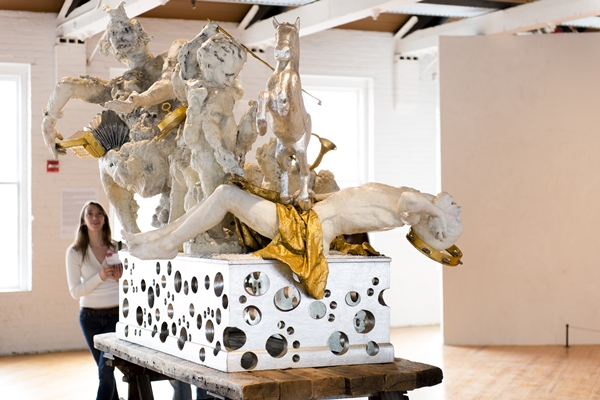
Photo: Gregory Cherin.
A review of the artist's midcareer retrospective.

Ranbir Sidhu

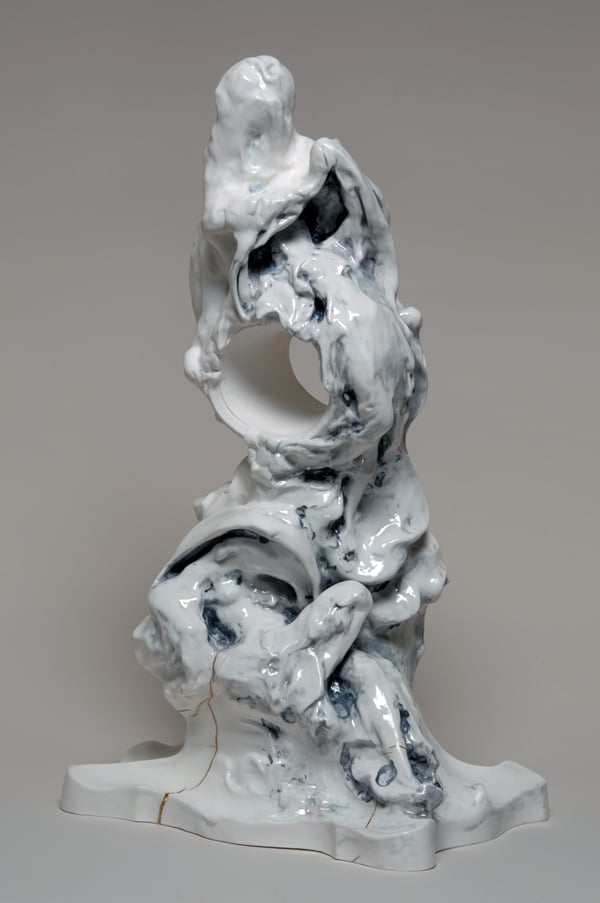
Izhar Patkin, Time Clipping the Wings of Love (2005–11)
Photo: Courtesy the artist.
In Time Clipping the Wings of Love (2009/11), Israeli-American artist Izhar Patkin takes a Sèvres porcelain, originally an erotic setting for a clock, and transforms it through physical deformation and the random application of glaze. It’s a piece that almost disappears in this vast exhibition, “Izhar Patkin: The Wandering Veil,” a midcareer retrospective on view at Mass MoCA through September 1. On closer inspection, figures emerge, arms, legs, torsos, breasts, women falling somehow. Splotches of dark brown drip along the melted women’s bodies, along with sharp lines of gold.
I passed it by the first time. Fortunately, the artist, a friend, was leading me on a tour. “It’s my favorite piece here,” he said. The glaze, when he applied it, was invisible, and so he had no real idea how it would turn out after firing. Splotches of dark brown dripped down along the mostly melted women’s bodies, along with sharp lines of gold. If he did it again, he laughed, he’d make it even uglier.
This tension, between the ugly and the beautiful, between the mundane and the profound, is on display throughout this sprawling show, which extends over two vast levels of the museum.
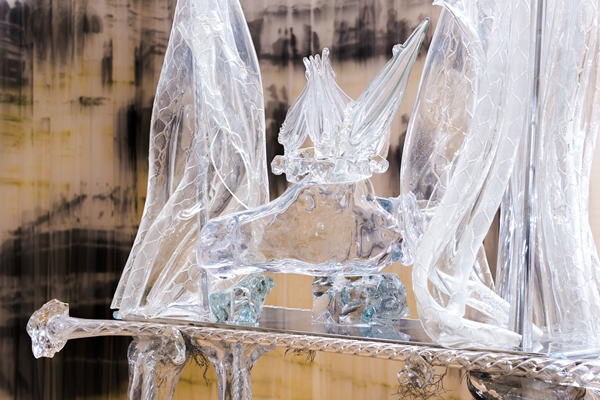
Izhar Patkin, installation view, “The Wandering Veil” (2014),
The Messiah’s glAss (2007)
Photo: Gregory Cherin.
The Messiah’s glAss (2007) tackles questions of orthodoxy and messianism in contemporary Israel. The decapitated head of a donkey, cast in glass, is set atop a glass table. A pair of stylized glass testicles hang below the table’s surface, as if its legs were the hind legs of an animal. The piece draws on imagery from the Book of Zohar, where the donkey becomes an image of Satan, and later Jewish theology, in which the so-called “Messiah’s Ass Generation,” lost to God and sunk in debauchery, is believed to usher in, by their extinction, the age of the Messiah.
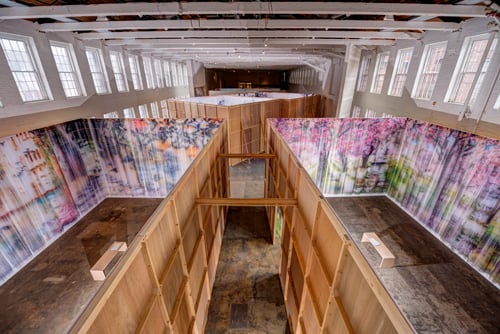
Izhar Patkin, installation view, “The Wandering Veil” (2014).
Photo: Gregory Cherin.
The heart of the show, filling one of the massive main galleries, is the American premiere of Patkin’s longstanding collaboration with Kashmiri-American poet Agha Shahid Ali. Five rooms have been constructed, each walled with paintings on undulating and often overlapping tulle curtains.
Each room was inspired by a poem by Ali. In one, The Veil Suite, the poet wrote a text specifically for Patkin to work from. Here, the figure of Jesus on the cross dances en pointe with a ballerina on railroad tracks that stretch arrow-straight to the horizon. On the opposite wall, on different railroad tracks, a man stands with his face hidden in a prayer shawl while a photographer crouches under an old-style camera’s hood to take his photograph. The mountains which circle the scene could as easily be in Colorado or the Himalayas.
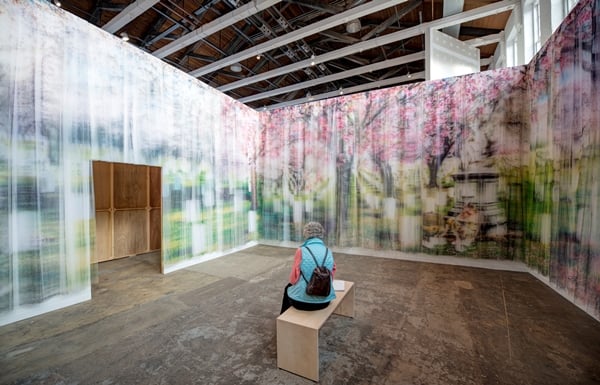
Izhar Patkin, installation view, “The Wandering Veil” (2014),
The Dead Are Here. Listen to the Survivors
Photo: Gregory Cherin.
In one of Patkin’s most gorgeous rooms, based on the poem by Ali, The Dead Are Here. Listen to the Survivors, a riot of spring colors brings to life a cemetery garden. In the image, a young woman leans her back against a statue’s pedestal while reading a book and a man lies on the grass next to his sleeping dog. White, unmarked tombstones stretch into the distance. The warmth of the day is palpable.
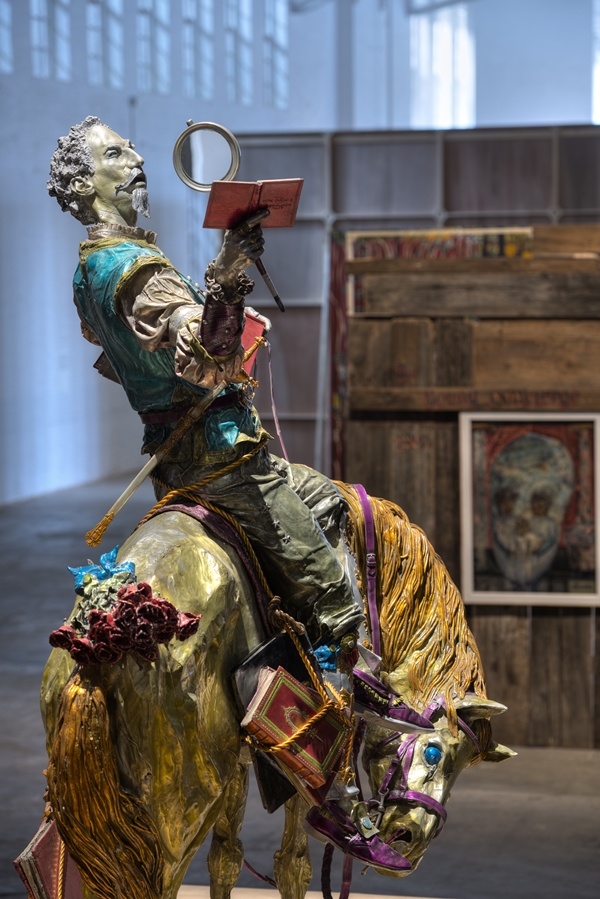
Izhar Patkin, installation view, “The Wandering Veil” (2014),
Don Quijote Segunda Parte (1987)
Photo: Gregory Cherin.
Another towering sculpture, Don Quijote Segunda Parte (1987), greets visitors at the exhibition’s entrance, showing the famous knight sitting astride his horse and reading a book of his own adventures while admiring himself in a hand mirror. Taken from an anecdote in Cervantes’s second volume, which humorously acknowledged that in the years since the first book of Don Quixote, others had sought to continue the knight’s tale, it brings to the surface questions of authenticity, the self, narrative, and the curious art of storytelling.
In its circularity, the knight’s vainglorious self-regard, where an imaginary figure reads invented tales about himself, we find a mirror for the tensions that illuminate much of Patkin’s work. Narrative, performance, the self and its creations, are seen in constant and ever-shifting flux. To look for answers here, Patkin suggests, is a fool’s errand, but to ask questions, and to continue asking them, though not a path to redemption, can lead to ever more refined ideas about the possibilities of being.
Ranbir Singh Sidhu is the author of Good Indian Girls and the winner of a Pushcart Prize.
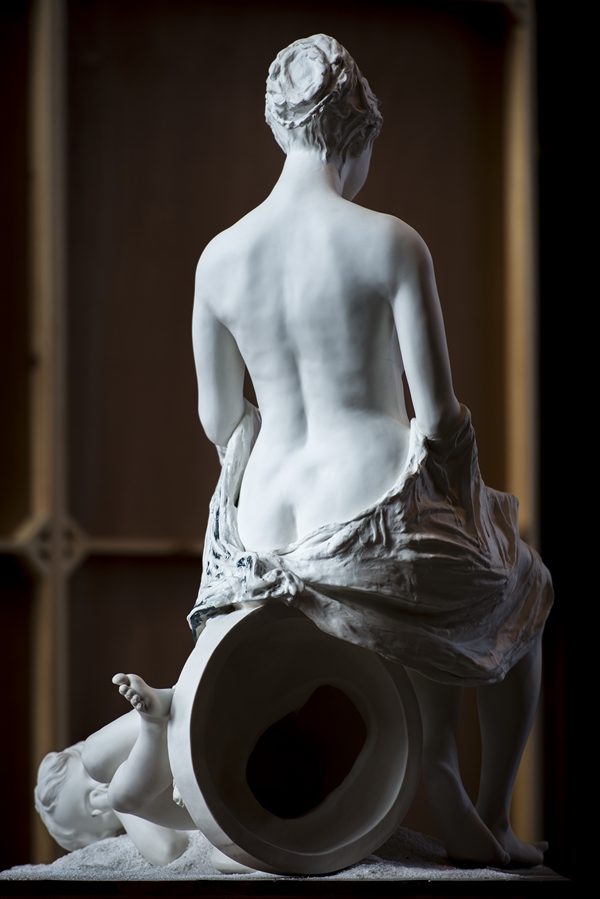
Izhar Patkin, installation view, “The Wandering Veil” (2014).
Photo: Gregory Cherin.